VRChat Performance Options
When playing VRChat, you can choose some graphics settings from the "Main Menu Settings" which can be found by pressing the popout button after opening the settings tab in the quick menu.
Avatar Performance

You can adjust settings in these categories to improve your performance.
Avatar optimizations
Block Poorly Optimized Avatars
This decides the minimum Avatar Performance Ranking that you want to show.
Clicking the left or right arrow lets you choose among performance ranks. Setting it to "Don't Block" permits all avatars to show, regardless of their performance rank.
Maximum Avatar Download Size
Avatars with a file size exceeding this amount will not be downloaded until you click "Show Avatar". This value defaults to 200MB. Clicking either the left or right arrow will adjust the value by 5MB at a time.
Setting this value below 5MB will set it to "No Limit". This means all avatars will be shown regardless of file size but may still be hidden by other settings such as minimum performance.
Avatars that go above this value will be shown as either their Fallback or their Impostor, if one is available.
Maximum Uncompressed Size
When avatars are downloaded, they are compressed. They must be decompressed to be viewed.
The uncompressed size of an avatar is related to how well some parts of it are optimized, such as texture size. As such, it can be useful to limit this, especially if you frequent instances with many people in them.
A recommended amount is 300MB.
Avatars that go above this value will be shown as either their Fallback or their Impostor, if one is available.
Physbones And Dynamic Bones
 > 🚧
> 🚧
This option will be removed in a future release, so please use PhysBones instead of Dynamic Bones.This button allows you to toggle whether or not dynamic bones are converted to PhysBones for your local point of view.We recommend keeping this option set to On at all times. This option is irrelevant for Quest or Mobile users, as Dynamic Bones was never available on those avatars.
Avatar Culling

Hide Avatars Beyond
This setting will hide all avatars beyond a specified distance. For example, if set to 15m, it will hide all avatars more than 15m away.
Hidden avatars will have all renderers turned off and replaced with a "ghost diamond" symbol. However, some components will continue to run to avoid consistency issues (animators) or other issues.
While adjusting this slider, a ring will appear around you to indicate the distance.
Maximum Shown Avatars
This setting allows you to choose the maximum number of avatars displayed simultaneously, sorted by distance.
For example, if you set this option to "10", the closest 10 avatars will be shown. All avatars past them will not be shown.
Always Show Friend Avatars
This toggle ensures that friends' avatars are always shown regardless of the distance or number of avatars already shown.
Allow Override With "Show Avatar"
This toggle ensures that people that you've selected "Show Avatar" for are shown regardless of distance or number of avatars already shown.
Graphics Quality

Multisample Antialiasing
Turning off MSAA can greatly increase your framerate, especially if you are GPU-bound.
You can adjust your anti-aliasing strength ("MSAA") from within VRChat. It defaults to 4x. Going higher can increase VRAM usage significantly, and lowering it to 2x or turning it off can greatly increase performance in some cases.
Quest MSAA
Quest MSAA is handled separately. Per Oculus' recommendations:
- Oculus Quest 1 is set to 2x MSAA.
- Oculus Quest 2, 3, and Pro is set to 4x MSAA.
This cannot be changed.
Graphics Quality
The Graphics Quality Settings allow you to adjust the Graphics Quality, multisample Antialiasing, Mirror Resolution, Shadow Quality, LOD Quality, and Particle Physics Quality.
This setting adjusts the Graphics Quality profile in use by VRChat. Graphics Quality profiles are sets of graphical settings that define many settings at once.
On PC, "VRC Ultra" is the default. You cannot change graphics quality on Quest.
The effectiveness of these settings might vary depending on the world you're in and your hardware. Generally, large open worlds that make use of LOD groups and dynamic lights will see the most change in performance when changing quality settings, while small enclosed worlds with baked lighting will see almost none.
For reference, here's how each of these graphics quality profiles are set up in the VRChat project.
VRC Low
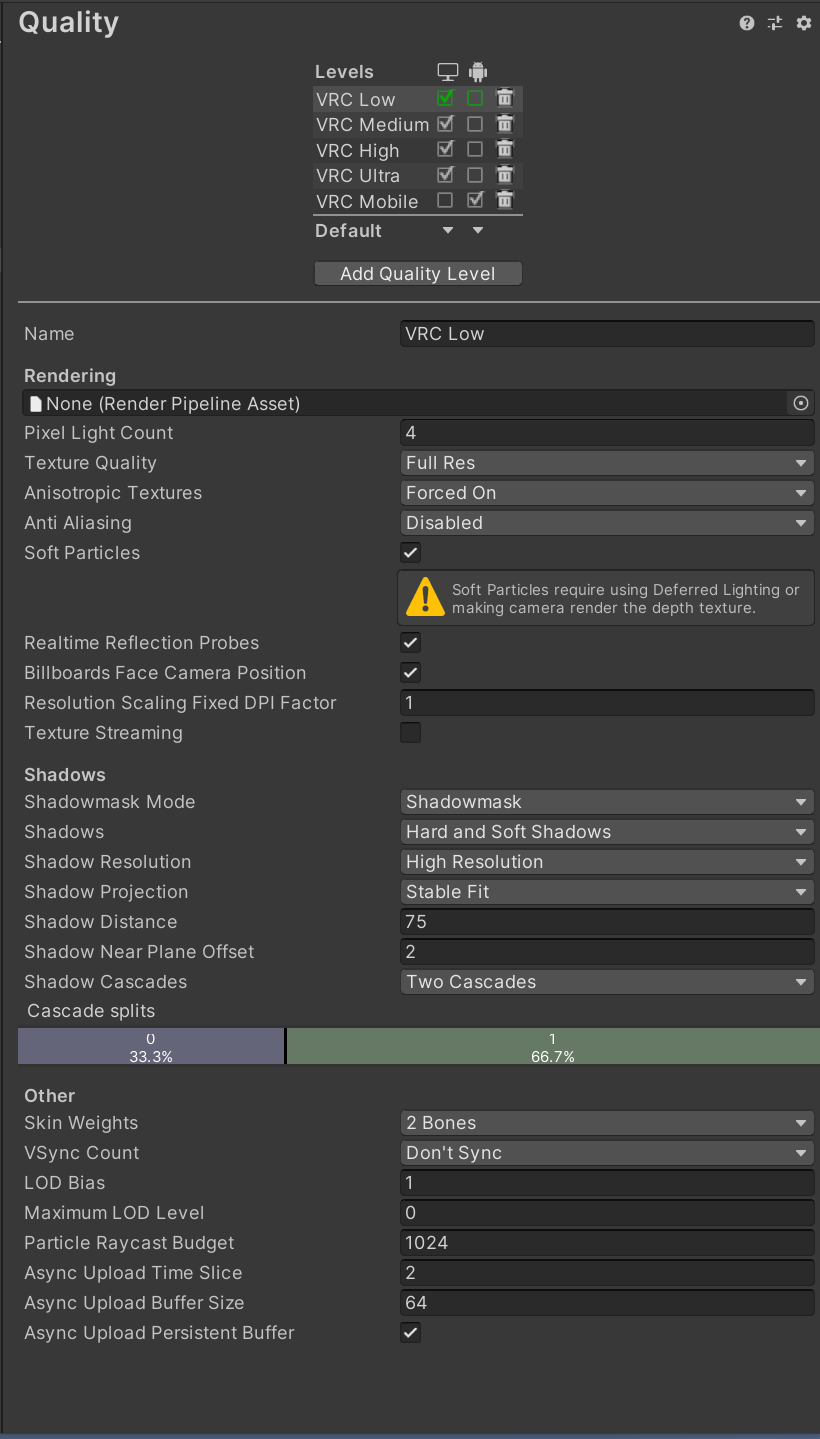
VRC Low settings on PCVR.
VRC Medium
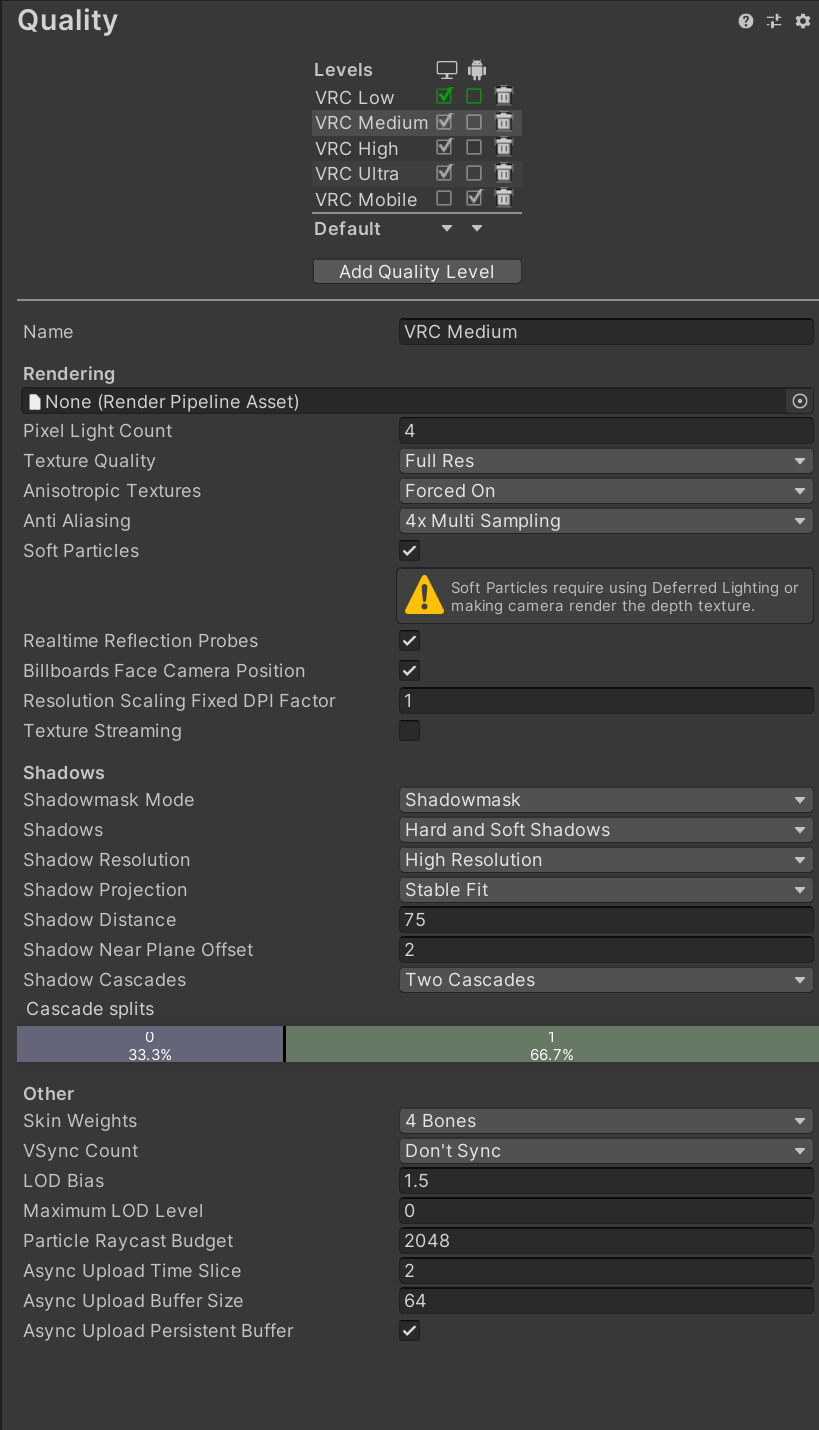
VRC Medium settings on PCVR.
VRC High
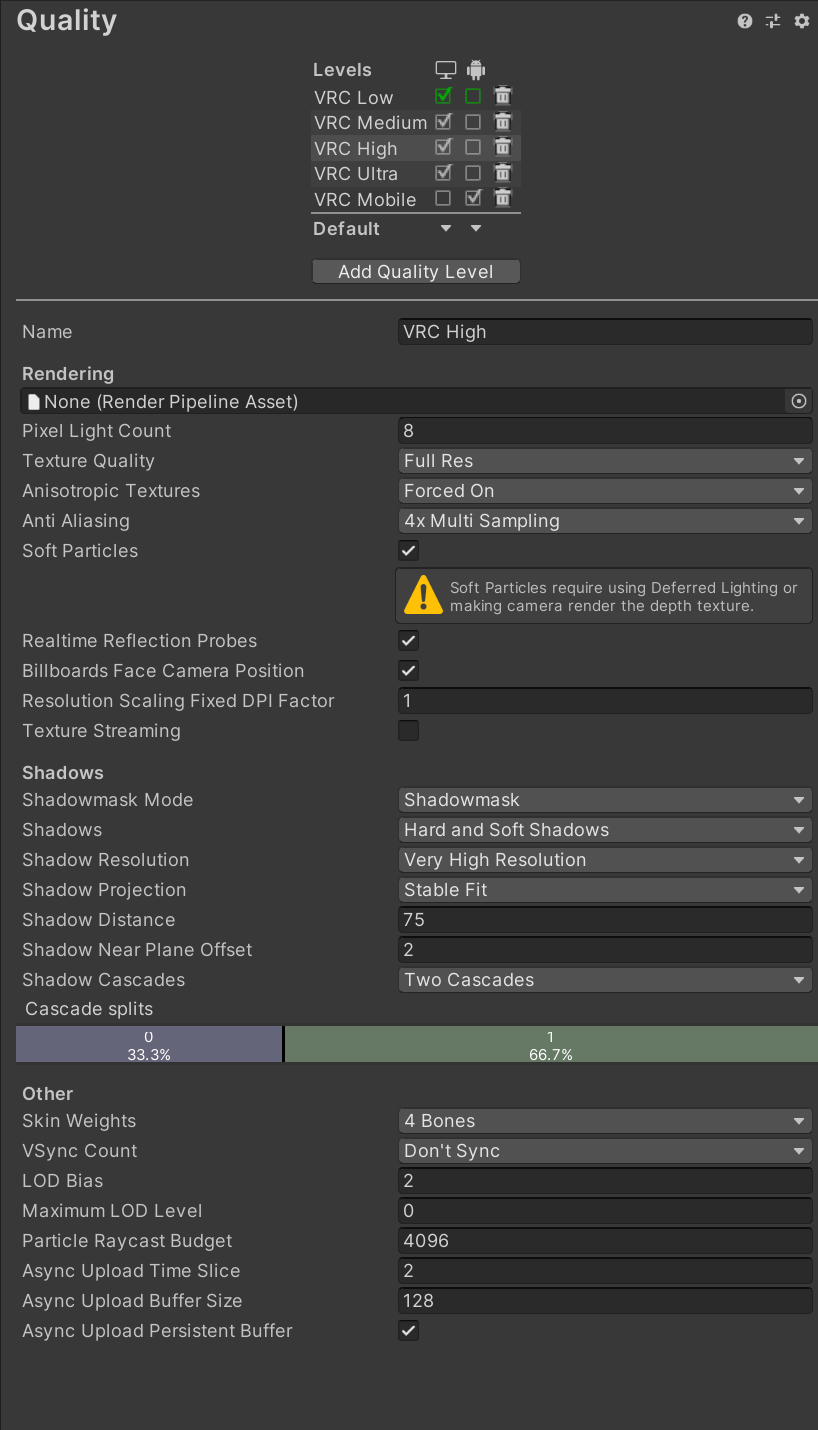
VRC High settings on PCVR.
VRC Ultra

VRC Ultra settings on PCVR.
VRC Mobile
The Oculus Quest only has one graphics profile. It is shown below.
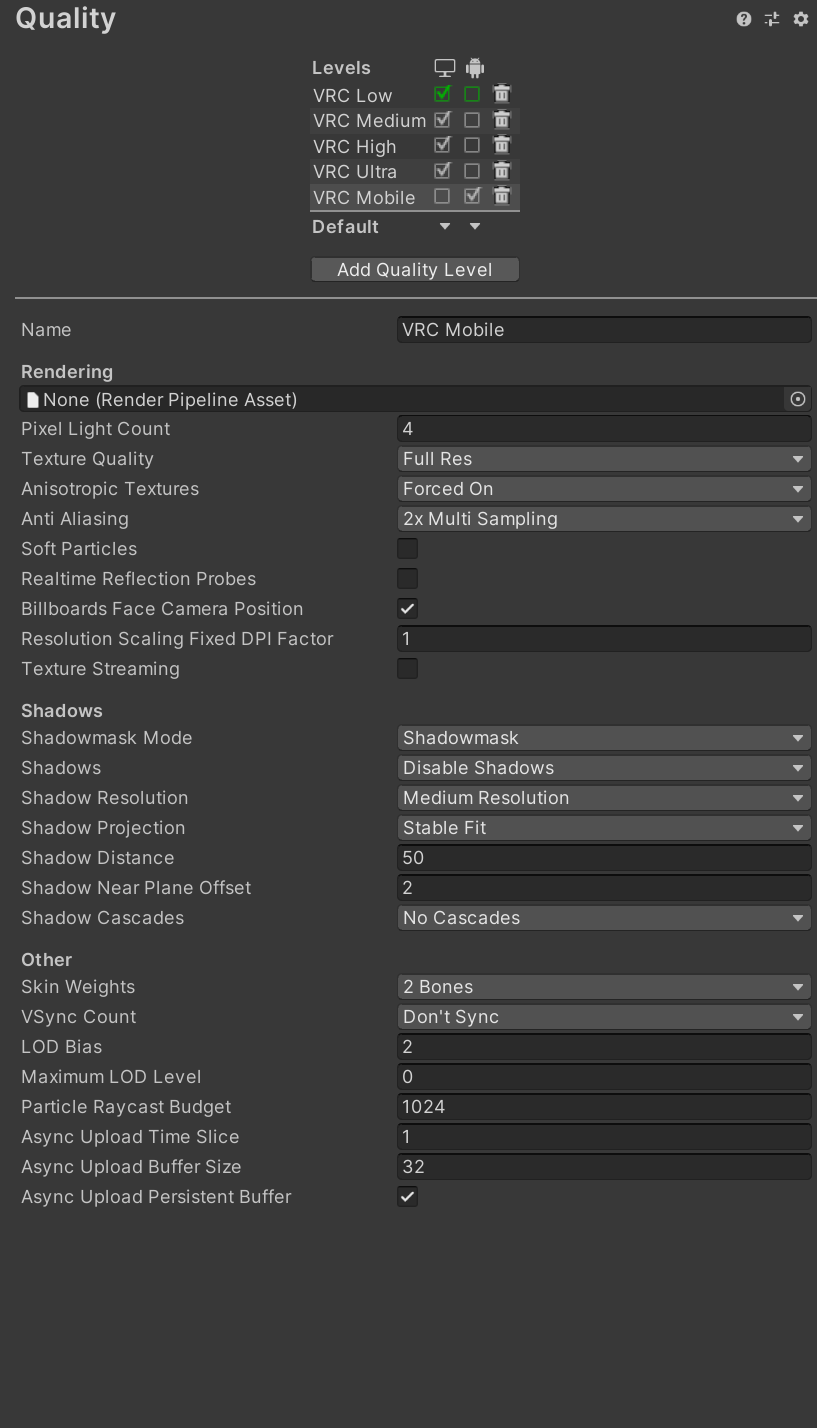
Mirror Resolution
Mirror resolution allows you to set the resolution of reflections displayed in mirrors they can be set to: Unlimited, Full, Half or Quarter. Unlimited resolution mirrors will significantly impact your performance . Use at your own risk.
shadow quality
The shadow quality setting allows you to adjust the quality of shadows being made by Realtime lights, baked light shadows will not be affected and do not affect performance.
you can set it to High, Medium or Low. here is a example of the shadow quality set to High and Low, the low Shadow Quality image is much more pixelated and rough, this is obvious around smooth areas like shoulders and some sharp areas like the ears .
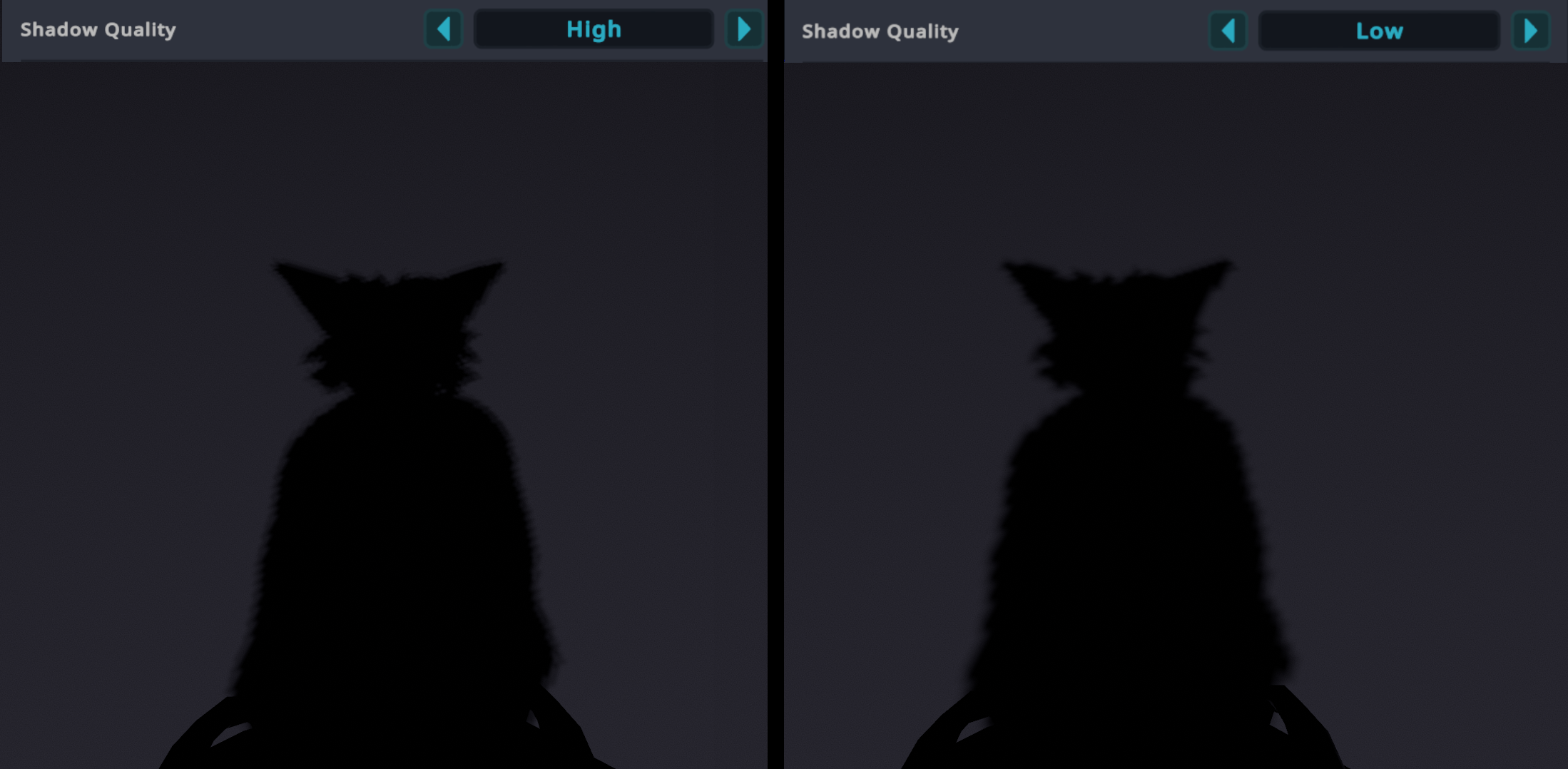
LOD Quality
When an object is between two LOD values, it will be biased toward picking the higher or lower-quality model based on this setting.
This can be seen in the earlier Graphics Quality Profile as LOD Bias.
At High, the LOD Bias is set to 2, which favors higher-quality models, while at Low, the LOD Bias is set to 1, which favors lower-quality models.
These are based on the size of the object on your screen, so the further you move from an object, the lower quality the model will become. However, not all worlds have LOD groups, as the world's creator must build them.
Particle Physics Quality
This setting affects the quality of physics, affecting particles like gravity or collision. Lowering this will improve performance while Particles are being made by avatars or worlds. There is also a setting to limit the amount of particles avatars can create, described in the Avatar Particle System Limits article.
Updated 1 day ago
